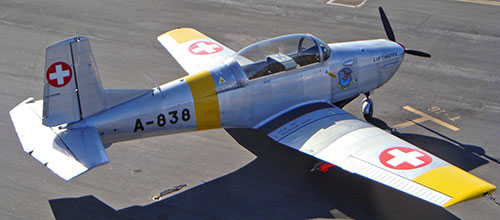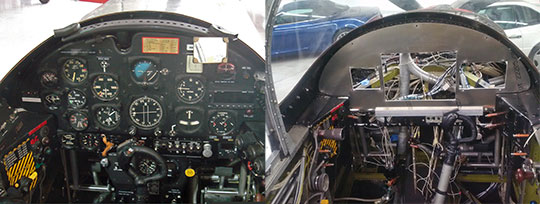Kami Pahlavan is restoring a Pilatus P3 at KAPA International, located at the Santa Monica Airport. He is an FAA licensed aircraft dealer and broker. He has a background in the automotive industry and regularly flies a Cirrus SR22.

The 1959 Pilatus P3
The Pilatus P3 is a military tandem trainer aircraft made by Pilatus for the Swiss Air Force. Only 89 of them were ever made for the SAF and they were in service until the early '90s, at which time they were fully retired. The airplane has a 6-cyl Lycoming engine and it is the father and piston version of the Pilatus PC7 & T6 Texan. The aircraft was originally certified in Switzerland but never in the US, so it is currently under the experimental/ exhibition category.
Until the project started, the P3 had all the original and legacy avionics, except a transponder. A Garmin 250 Com/GPS, a back-up com, and an ELT was added. The aircraft runs on a 24V system and has a generator.
All avionics and wiring were removed, and a full glass cockpit will be installed. The new panel will consist of a complete Garmin G3X touch system with a GDU460 in front and another in the back, GEA 24 engine monitoring system, GTR20R com, GMA245 audio panel, GNS 430 Com/GPS/Nav, GTX 23 ADS-B out, GDL39R ADS-B in, GAD29 IFR interface, and 2 axis Garmin auto pilot with a GMC 305 auto pilot head, and 2 GSA28 servos for pitch and roll. A GRT Mini-X serves a back-up EFIS and is totally independent of the Garmin System or the VP-X.
Pilatus P3 panel

The P3 panel before (left), and the simplified version ready to receive modern avionics (right)
A Vertical Power VP-X Pro was installed to serve as the electrical system for the majority of the aircraft. A few of the legacy circuit breakers of the original electrical system are being preserved to power the flaps, the landing gear, and to act as a back-up for some of the avionics. A TCW IBBS-12V-6ah with a voltage converter was installed as a back-up battery.
"The use of the VP-X will allow us to use essentially any switch we want as they will not carry any loads," says Kami. "This will give us a very clean panel with no circuit breakers, and let us manage all of the electrical system (with the exception of flaps and landing gear) from the PFD very much like today's modern jets."
Pilatus P3 Electrical System

The legacy circuit breaker panel (left), the new VP-X Pro (center, wrapped in blue tape to protect the finish during renovation), the wiring diagram produced by the Vertical Power Planner guides the wiring process (right)
